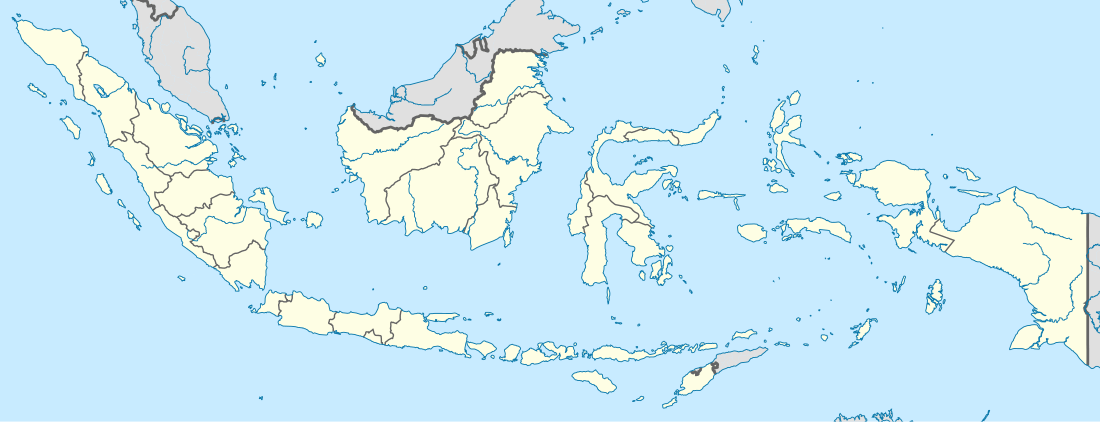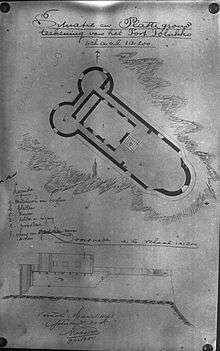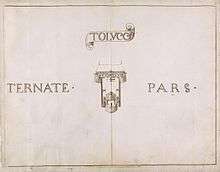Fort Tolukko
Fort Tolukko is a small fortification on the east coast of Ternate facing Halmahera. It was one of the colonial forts built to control the trade in clove spices, which prior to the eighteenth century were only found in the Maluku Islands. It has been variously occupied by the Portuguese, the native Terate Sultanate, the Dutch, the British and the Spanish. It was abandoned as a fort in 1864, renovated in 1996, and is now a tourist attraction.
| Fort Tolukko | |
|---|---|
 Fort Tolukko in 2012 | |
 Location within Indonesia | |
| General information | |
| Architectural style | Iberian colonial |
| Town or city | Ternate |
| Country | Indonesia |
| Coordinates | |
| Construction started | 1512 |
| Technical details | |
| Structural system | Stone built artillery fort |
Description
Fort Tolukko is located in the village of Duga Duga on the edge of Ternate City on the island of Ternate, one of the Maluku Islands in modern Indonesia. It is a 6 metres (20 ft) tall, stone built fort, sitting on a cape about 10.5 metres (34 ft) above sea level. Fort Tolukko's unusual phallic layout is a function of the immediate topography.[1] Its small narrow layout with two bulwarks is distinctively Portuguese, different with the Dutch built Fort Oranje and Fort Kalamata. Its primary function was to dominate a rare coral reef-free landing point, directly in front of the fort. It was built to hold a garrison of 160.[2]
Construction and early history

After the arrival of Islam and the decline of Majapahit influence, the government organisation of North Maluku changed to a Sultanate by the fifteenth century, when the first Europeans arrived.[2] Ternate was one of the so-called Spice Islands. Until the 18th century, cloves grew only on a few islands in the Moluccas: Bacan, Makian, Moti, Ternate, and Tidore. The trade in cloves and other spices from the Molaccas was a fabulously wealthy one and the European colonial powers competed to control it.[3]
In November 1511. the Portuguese in Malacca learnt of the location of the Spice Islands in the Moluccas, and sent an expedition led by António de Abreu to find them. This arrived in early 1512, with Abreu going to Ambon while deputy commander Francisco Serrão went to Ternate. The Portuguese in Ternate was welcomed by the Ternate Sultanate, partly because the Portuguese promised to help the Ternatese in their fight against their rival, the Sultanate of Tidore, which was allied with the Spanish. The Ternate Sultanate allowed the Portuguese to build several forts around Ternate and to establish a trade port. One of the first forts built was Fort Tolluko, which was constructed in 1512 at the order of Francisco Serrão and at the time was named Fort Saint Lucas.[2]
It became clear to the Ternatese that the Portuguese intention was not merely to establish a trading port, but to monopolize the spice trade. This was formalised in a treaty which obliged the Ternatese to sell the spices as cheaply as possible to the Portuguese. In 1533, the Ternatese, led by Dajalo, tried to captured the Portuguese forts, but failed. António Galvão managed to calm the situation and maintain peace in Ternate enabling the Portuguese to maintain their monopoly over the spice trade in the Maluku Islands. Their position was strengthened by a new treaty made in 1570 between Governor of the Moluccas, Lopez de Mesquita, and the Sultan of Ternate, Khairun Jamil.[2]
However, not long after the treaty, Jamil was murdered on the orders of de Mesquita. Khairul's son Babullah declared war, which lasted for seven years. Gradually, the Portuguese forts were taken by Ternate and in 1577 the Ternatese managed to expel the Portuguese from the region.[2] The fort was used by the Sultan of Ternate as a fortified royal residence.[1]
Later history

The Dutch expanded in the East Indies in the early 17th century. As a part of this expansion they captured Fort Tolukko in 1605 from the Ternate Sultanate, renaming it Fort Hollandia. In 1610 it was repaired and improved by Jan Pieter Both for the Dutch East India Company. In 1611 the Governor of the Spanish Philippines, Captain-General Juan de Silva, dispatched an expeditionary force under Captain Fernando de Ayala to Ternate which captured the fort. However, with the Dutch fortress of Fort Oranje lying between Fort Tolukko and the main Spanish fortress of Kastella, the Spanish found it difficult to maintain Fort Tolukko, and it was abandoned by 1613.[4]
In 1661, The Dutch government allowed the Ternate Sultan Mandar Syah of Ternate to occupy the Fort with his soldiers.[5] At some point it was renamed Fort Tolukko after the tenth ruler of the Ternate Sultanate, Kaicil Tolukko, whose reign started in 1692.[1] On April 16, 1799, a small group of Tidorese soldiers led by Kaicil Nuku, the nineteenth Sultan of Tidore, attacked Tolukko Fort. They were rapidly forced back by the combined forces of Ternate and Dutch East India Company. Continuous war between Ternate and Tidore greatly reduced the population of the city of Ternate, with many dying of starvation, being killed in the war, or fleeing to Halmahera.[5] In 1810 the fort was occupied by the British during an invasion of the Moluccas during the Napoleonic Wars.
In 1864, the Dutch resident P. Van der Crab ordered the dilapidated buildings inside Fort Tolukko demolished and the fort vacated. In 1996, the fort area was renovated, but the lack of a proper conservation process resulted in the loss of some of the historic elements of the fort, such as the tunnels which connected the fort to the landing point on the beach.[5]
See also
| Wikimedia Commons has media related to Fort Tolukko. |
References
- van de Wall 1928, p. 254.
- Jaringan Kota Pusaka Indonesia 2018.
- Turner 2004.
- Lobato 2012, p. 186.
- Barry Kusuma 2015.
Works cited
- Barry Kusuma (2015). "Benteng Tolukko" [Tolukko Fort]. Indonesia Kaya (in Indonesian). Indonesia Kaya. Archived from the original on November 15, 2015. Retrieved November 15, 2015.CS1 maint: ref=harv (link)
- "Benteng Tolukko di Ternate (Fort Tolukko of Ternate)". Jaringan Kota Pusaka Indonesia (Urban Heritage Indonesia) (in Indonesian). Jaringan Kota Pusaka Indonesia (Urban Heritage Indonesia). 2018. Archived from the original on 2015-11-15. Retrieved 13 December 2018.
- Keppel, Jaap (2004). De Molukken. VOC Architecture Banda, Ambon, Leaser Eilanden & Ternate. Krommenie.CS1 maint: ref=harv (link)
- Lobato, Manuel (2012). "From European-Asian conflict to Cultural Heritage". Portuguese and Luso-Asian Legacies in Southeast Asia, 1511-2011, vol. 2: Culture and Identity in the Luso-Asian World: Tenacities & Plasticities: 186.CS1 maint: ref=harv (link)
- Turner, Jack (2004). Spice: The History of a Temptation. New York: Vintage books. ISBN 978-0-375-70705-6.CS1 maint: ref=harv (link)
- van de Wall, V.I. (1928). De Nederlandsche Oudheden in de Molukken. Martinus Nijhoff. p. 253.CS1 maint: ref=harv (link)